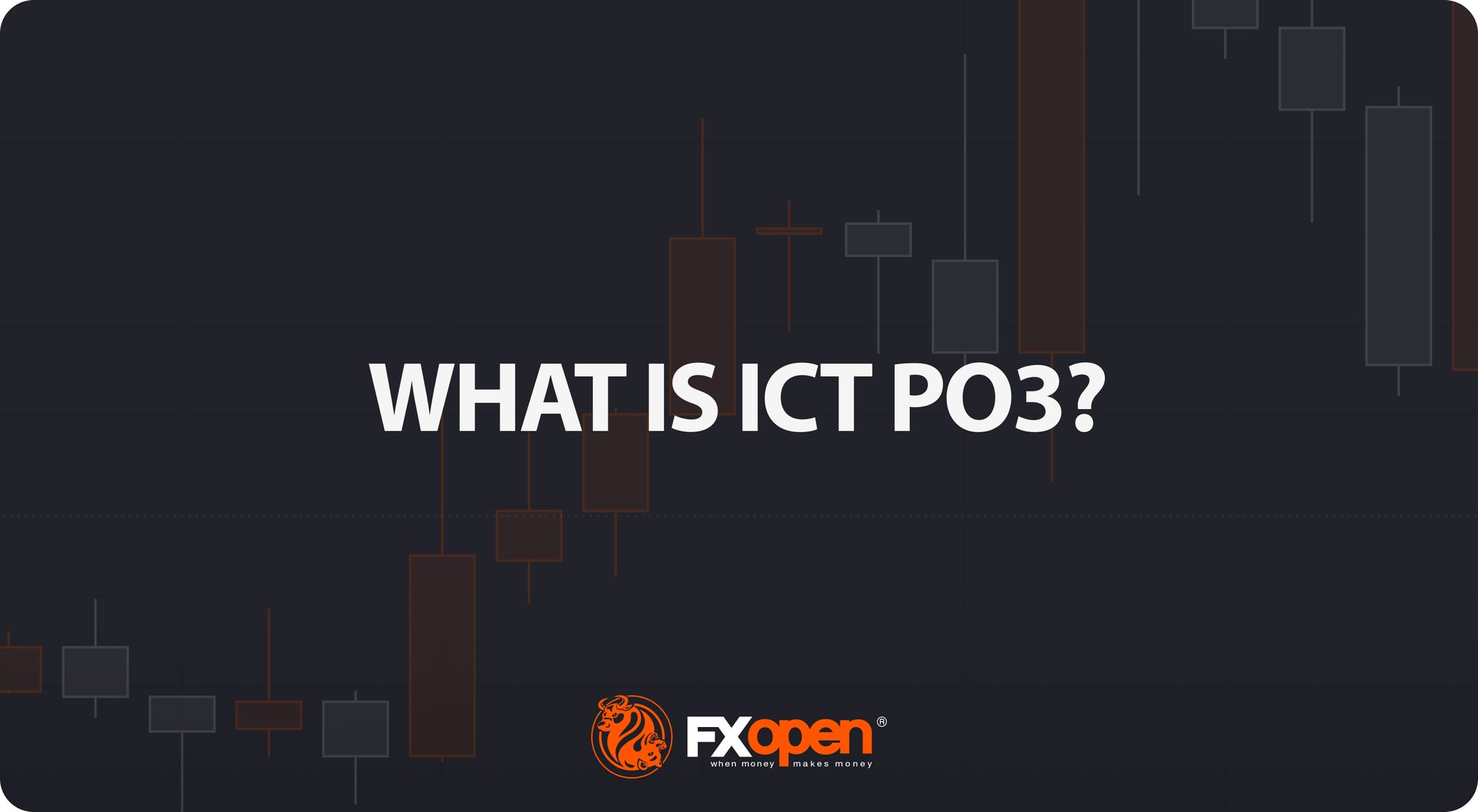FXOpen

The ICT Power of 3 (PO3) is a structured approach to price action analysis that aims to interpret institutional market behaviour. It divides market movement into three distinct phases: accumulation, manipulation, and distribution. Recognising these phases may help traders assess potential areas of interest and align their strategies with broader market dynamics.
This article outlines the core principles of the Power of 3 framework, providing a detailed examination of how it is applied in the context of institutional order flow and market structure.
Introduction to the ICT PO3 Trading Model
The ICT Power of 3 (PO3), or the AMD setup, is a strategic trading framework developed by Michael J. Huddleston, better known as the Inner Circle Trader. This approach revolves around three critical phases: accumulation, manipulation, and distribution, which collectively may help traders understand and anticipate market movements.
Accumulation Phase
During this phase, smart money or institutional investors accumulate positions within a price range, often leading to a period of low volatility and sideways movement. This stage sets the groundwork for future price movements by creating a base of support or resistance.
Manipulation Phase
The manipulation phase involves deliberate price moves by smart money to trigger stop losses. In a bullish scenario, prices may dip below the established range, while in a bearish market, prices might spike above the range. This phase is seen as being characterised by sharp, misleading price movements aimed at manipulating liquidity.
Distribution Phase
Following manipulation, the distribution phase sees smart money offloading their positions, leading to significant price movements in the intended direction. For bullish trends, this involves a strong upward move, whereas, in bearish conditions, it results in a sharp decline. This phase marks the realisation of the strategic positions built during the accumulation phase.
Understanding this ICT concept allows traders to align their strategies with the actions of institutional investors, potentially enhancing their ability to make informed trading decisions. The ICT PO3 strategy is versatile, applicable across different timeframes and financial instruments, making it a valuable tool for traders in various markets.
Below, we’ll discuss each of these three phases in more detail. Consider following along on FXOpen’s TickTrader trading platform.
The Accumulation Phase
The accumulation phase is a crucial initial stage within the Power of 3 trading strategy. It represents a period where institutional investors, often referred to as smart money, quietly build their positions in a particular asset. This phase is characterised by relatively low volatility and sideways price movement, typically near key support or resistance levels.
During accumulation, the market tends to range within a narrow band as large players gradually buy into the asset without significantly driving up its price. This steady acquisition reflects their confidence in the asset's future appreciation. Recognising the accumulation phase involves monitoring for signs such as low-volatile, ranging price action and potential increases in trading volume without major price changes.
Indicators of the accumulation phase include:
- Low Volatility: The asset trades within a tight range, showing little directional bias.
- Support Levels: Accumulation often occurs near historical support or resistance levels where the price is deemed under or overvalued by institutional investors.
- Increased Volume: There may be a gradual rise in volume as smart money accumulates positions, signalling their interest without causing sharp price movements.
Specifically, this range is also intended to trap retail traders on both sides of the market. In a bullish accumulation, for example, where the price will eventually break upwards, the range will trap bullish traders buying from the support level inside of the range. Given that these traders will most likely set their stop losses below the range, this paves the way for the next stage: manipulation of liquidity.
However, some traders will also take a short position in this range, anticipating that price will continue to break lower. These traders add fuel to the distribution leg discussed later.
The Manipulation Phase
The manipulation phase is a pivotal part of the ICT PO3 trading strategy. This stage is marked by deliberate actions from institutional investors to create market conditions that mislead and trap retail traders. It follows the accumulation phase, where positions are built, and precedes the distribution phase, where these positions are realised.
Characteristics of the Manipulation Phase:
- Deceptive Price Movements: During this phase, the price moves sharply in a direction opposite to the expected trend. In a bullish setup, prices might dip below the established range, while in a bearish setup, they might spike above the range. These moves are designed to trigger stop-loss orders, encourage breakout traders to enter positions and ultimately generate liquidity for the smart money’s large orders.
- Triggering Retail Traps: The primary goal is to shake out early traders by hitting their stop-loss levels. For instance, a sudden dip in a bullish market might make retail traders believe that the market is turning bearish, prompting them to close their positions.
- Creating Liquidity: By inducing these price movements, smart money creates liquidity that allows them to add to their positions at more favourable prices. This phase is crucial for building the necessary conditions for the subsequent distribution phase.
Recognising Manipulation:
- False Breakouts: Characterised by sharp, sudden moves that quickly reverse. These are often designed to lure traders into thinking a breakout has occurred.
- Price Action Signals: Price action that doesn’t align with the overall market structure or sentiment can be a sign of manipulation. This can be especially true after a long uptrend or downtrend, signalling potential exhaustion.
For example, in a bullish market, after a period of accumulation where prices have stabilised within a range, a sudden drop might occur. This drop triggers stop-loss orders and panics retail traders into selling. It also encourages some to trade what appears to be a bearish breakout. Smart money then buys these positions at lower prices, preparing for the distribution phase where they push the prices up sharply.
The Distribution Phase
The distribution phase is the final stage in the Power of 3 trading strategy, where smart money begins to offload their positions built during the accumulation phase. This phase follows the manipulation phase, and it is characterised by strong price movements in the direction opposite to the manipulation.
Key Characteristics of the Distribution Phase:
- Significant Price Movement: This phase involves substantial price changes as institutional investors begin to realise their positions. In a bullish scenario, this means a sharp upward movement; in a bearish scenario, a sharp decline.
- High Volume: The distribution phase is often accompanied by high trading volume, indicating that a large number of positions are being sold or bought back.
- Market Confirmation: During this phase, the true market trend that was obscured during the manipulation phase becomes evident. The price moves in the direction of the original accumulation, confirming the intent of the smart money.
- Retail Trader Participation: Many traders have been shaken out of their positions, including those who were wrong about the initial breakout’s direction and those who were correct but had their stop loss triggered by the manipulation phase. They now pile back into the trade, fueling this strong upward or downward leg.
Recognising the Distribution Phase:
- Price Action: Traders look for strong, sustained movements in price, often with large candles. For a bullish trend, this means a consistent upward movement; for a bearish trend, a consistent downward movement.
- Volume Analysis: Increased trading volume during these price movements indicates distribution.
- Breaking Market Structure: The high or low of the accumulation/manipulation phase will be traded through.
- Technical Indicators: Use of tools like moving averages and support/resistance levels may help confirm the transition into the distribution phase.
For example, in a bullish market, smart money begins to buy aggressively after the price has been manipulated downwards to create liquidity. This buying pressure pushes the price up sharply, signalling the start of the distribution phase. Traders can look for increased volume and price action breaking above previous resistance levels as confirmation.
Practical Application of ICT PO3
The ICT PO3 strategy may be applied by traders through a structured approach involving higher timeframe analysis and keen observation of price movements. Here's how traders typically utilise this strategy:
Setting the Daily Bias
Traders often start by establishing their market bias for the day. This involves analysing higher timeframes to determine the overall market trend. Understanding whether the market is bullish or bearish sets the foundation for the day’s trading strategy.
Marking the Day's Open
After setting the bias, traders mark the opening price of the day. This price point is critical as it serves as a reference for potential manipulation.
Identifying Manipulation
Traders look for price movements beyond the day's open and the established range boundaries. For a long bias, they observe for manipulation below the open, while for a short bias, they look above the open. This stage is crucial as it indicates where smart money is likely manipulating the market to create liquidity.
Entry Signals
While a trader can simply enter once price trades beyond the day’s open, many choose to confirm the trade. Using a 5-15 minute chart, they might look for signals such as:
- Price moving into a significant area of liquidity beyond a key swing high or low.
- A break of established market structure, such as price beginning to move above previous swing highs in a bullish setup (known as a change of character, or ChoCh).
- Chart patterns or candlestick patterns that indicate a reversal or continuation, such as a hammer/shooting star, wedge, quasimodo, etc.
- A moving average crossover that supports the expected price direction.
- Momentum indicators showing waning momentum in the manipulated direction.
Traders typically place stop losses beyond the manipulation high or low to potentially manage risk here.
Distribution Phase
If an entry is missed during the manipulation phase, traders can look for entries during the distribution phase. Although this phase may offer a less favourable risk-to-reward ratio, it still may have trading potential. Traders might wait for a market structure break or ChoCh, followed by a pullback, setting stop losses either beyond a recent swing high/low or beyond the manipulation high or low.
ICT Power of 3 Example
On the GBPUSD 15m chart above, the day open acts as a support level, marking the accumulation phase. A candle wicks below the range, followed by a price break above the range, which then sharply reverses, indicating the manipulation phase. After taking liquidity, price rebounds sharply.
On the 5m chart, a break above the downtrend structure creates a change of character (ChoCh) before price pulls back and breaks above the manipulation high, signalling a bullish market shift. Subsequent pullbacks might be excellent entry points for traders who missed the manipulation phase entries before price marks up further.
The Bottom Line
Understanding and applying the ICT Power of 3 strategy can support a structured approach to analysing market movements. By identifying the phases of accumulation, manipulation, and distribution, traders may gain insights into potential institutional activity and adjust their decisions accordingly. If you want to use ICT Power of 3 strategy, consider opening an FXOpen account for advanced trading tools, tight spreads, and low commissions.
FAQ
What Is PO3 in Trading?
The ICT Power of 3 (PO3) is a trading strategy developed by Michael J. Huddleston, known as the Inner Circle Trader. It involves three key phases: accumulation, manipulation, and distribution. These phases may help traders understand market movements by aligning their strategies with institutional investors.
What Is the Power of 3 ICT Entry?
The Power of 3 ICT entry involves identifying optimal points to enter trades during the phases of accumulation, manipulation, and distribution. Traders typically look for signs of price manipulation, such as false breakouts, and then enter trades in the direction of the anticipated distribution phase.
How Does the Power of 3 Work?
The ICT Power of 3 can be an indicator of potential smart money involvement. It works by breaking down market movements into three phases:
1. Accumulation: According to theory, smart money is expected to build positions.
2. Manipulation: Traders monitor price movements that extend beyond the day's opening level and the defined range limits.
3. Distribution: Smart money exits positions, leading to significant price movements in the intended direction.
How Do Traders Use the Power of Three?
The Power of Three is a trading concept that divides market behaviour into three phases: accumulation (smart money quietly buying or selling), manipulation (price moves triggering retail traders’ orders), and distribution (smart money exits positions). Traders use it to understand market structure, anticipate price moves, and align their trades with institutional activity.
This article represents the opinion of the Companies operating under the FXOpen brand only. It is not to be construed as an offer, solicitation, or recommendation with respect to products and services provided by the Companies operating under the FXOpen brand, nor is it to be considered financial advice.
Stay ahead of the market!
Subscribe now to our mailing list and receive the latest market news and insights delivered directly to your inbox.








